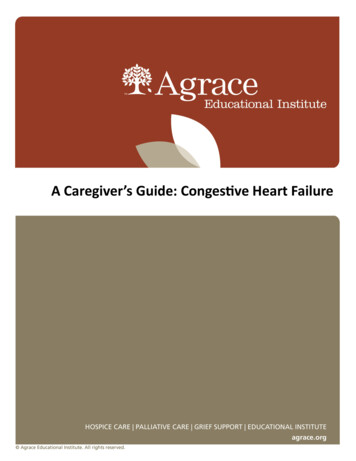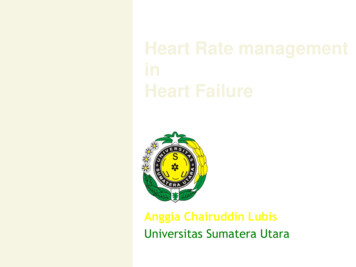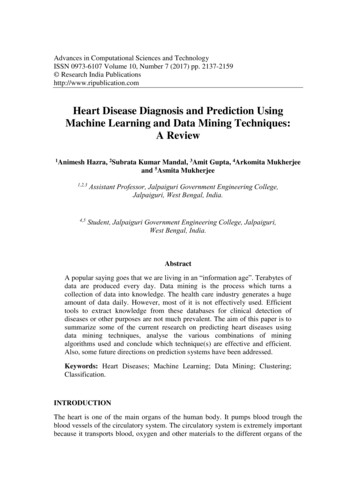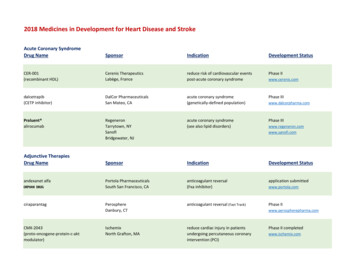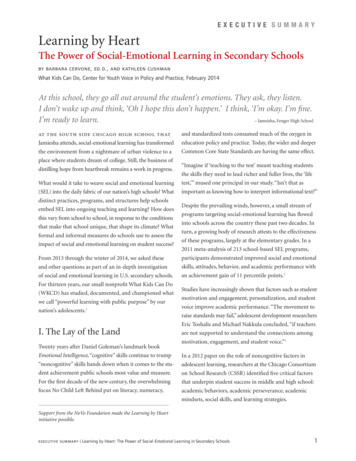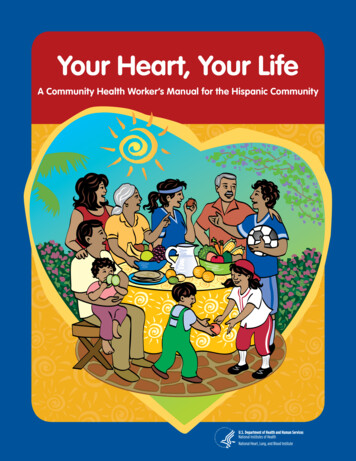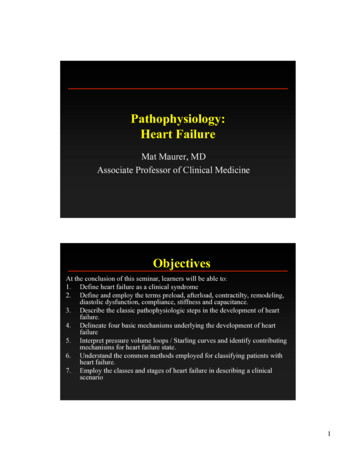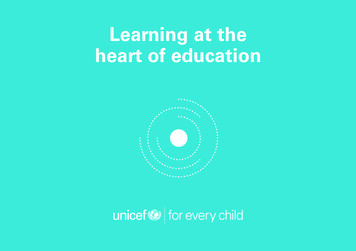
Transcription
Learning at theheart of educationUNICEF Education Strategy 2019–2030 Every Child Learns
for every child, EDUCATIONEvery child has the right to go to school and learn, regardlessof who they are, where they live or how much money their family has.UNICEF remains steadfast in its commitment to realize the rights ofall children, everywhere, and to achieve the vision of the 2030 Agenda forSustainable Development, a world in which no child is left behind.
Progress has been made to provide access toeducation for children around the world.Worldwide in the early 1950s, about 50 per cent of primaryschool age children were out of school. As late as 1970,the figure stood at 28 per cent. Today, in one of themost remarkable development achievements of the pasthalfcentury, that figure has come down to 9 per cent.but millions of children, even those who are inschool, are not learning. The breadth and depthof this learning crisis provides the greatest globalchallenge to preparing children and adolescentsfor life, work and active citizenship.UNICEF Education Strategy 2019–2030 Every Child Learns
More children and adolescents todayare enrolled in pre-primary, primary andsecondary education than ever before.Yet, for many of them, schooling doesnot lead to learning.a globallearning crisisAt current rates, by 2030, of the 1.4 billionschool-age children in low- and middle-incomecountries, 420 million will not be on trackto learn the most basic skills in childhood,and 825 million will not be on track to acquirethe basic secondary-level skills they needto succeed in life, school and work.The lesson of the learning crisis is clear: theconventional assembly of education inputsis not improving learning outcomes. A new,more radical approach that focusses onenhancing learning outcomes is long overdue.
53%of children in low- andmiddle-income countriescannot read and understand a simplestory by the end of primary schoolin SubSaharan Africa,the number is87%Source: The World BankUNICEF Education Strategy 2019–2030 Every Child Learns
Snapshot of learning in different regions% of children who cannot read and understand a simple text by age 1087%Sub-SaharanAfrica63%Middle Eastand North Africawho isleft behind?58%South Asia51%Latin Americaand the Caribbean21%East Asiaand the Pacific13%Europe andCentral AsiaSource: The World Bank
onlyonly22%50%are enrolled in pre-primary,compared to 83% in highincome countrieshave access to primaryeducation, comparedto a global levelof more than 90%of children in lowincome countriesadolescents of lowersecondary school age living ina low-income country have analmost1 in 3chance of beingout of school.of refugee childrenmore than12million girlsare married in childhoodeach year, with littlechance of completingtheir educationIn a high-income country,it is only 1 in 50UNICEF Education Strategy 2019–2030 Every Child Learns
the strategicshift
learning at theheart of educationUNICEF Education Strategy 2019–2030 Every Child Learns
Strategic frameworkdata andevidenceto address thelearning unicationand tyengagementresourceslearningcrisis
equitable accessto learningopportunitiesevery child learnsgoalsimprovedlearning andskills for allimprovedlearning inemergenciesvisionUNICEF Education Strategy 2019–2030 Every Child Learns
ACT NOWUNICEF calls upon partners to join forces and step upaction to fulfill the promise that every child learns
UNICEF and partners LEARNING work to create a learning revolution for every childEQUITY AND INCLUSION increase efforts to reach the most vulnerablechildren and to eliminate gender inequality in educationdrivechangetogetherEDUCATION IN EMERGENCIES AND FRAGILE CONTEXTS ensure children in humanitarian and fragile contextshave access to quality education opportunitiesEARLY CHILDHOOD EDUCATION invest early in quality early childhood educationand build strong learning foundationsQUALITY ALTERNATIVE LEARNING PATHWAYS FOR ADOLESCENTS encourage a rapid expansion of opportunities inand outside the education system for all childrenPRIMARY AGE EDUCATION build on the existing priority of addressinginequitable access to quality educationUNICEF Education Strategy 2019–2030 Every Child Learns
spotlightonsolutionsThrough blended in-personand online learningopportunities in Mexico,learning outcomesare improving amongadolescents in violenceaffected areas.To ensure inclusiveeducation, childrenwith disabilities areintegrated in regularclassrooms in Serbia.In Venezuela, the mostvulnerable are given accessto multilingual educationand recreational activities.'Through a technologyplatform, municipalitiesin Brazil can identifyout-of-school children andtake the necessary stepsto ensure their enrollment.Plastic waste is recyledinto building bricks toconstruct cost-effectiveclassrooms and toprovide access toeducation and betterlearning enviornmentsin Cote d'Ivoire.
In Lebanon, marginalizedyoung people are supportedthrough training in designthinking, social entrepreneurshipand digital skills.Portable ger (tent)kindergartens ensurethat children of nomadicfamilies in Mongoliacan access quality ECE.More than 2000 learningcenters have been establishedfor children in the Rohingyarefugee camps of Cox's Bazarin Bangladesh.Life skills and socialcohesion education isadvanced through gamebased sports in Jordan.In Cambodia, innovativefinancing supportsthe acceleration ofeducation reforms.In Kenya, Rwanda andUganda, the accessible digitaltextbook project makes digitallearning materials accessiblefor children with disabilities.The most marginalizedchildren in Sudan are reachedthrough applied gaming andpersonalized pupil engagement.UNICEF Education Strategy 2019–2030 Every Child Learns
Education has hugereturns on investment
420 million people would be lifted out of povertywith completion of primary and secondary school.An extra year of schooling, on average,increases a person’s income by 10 per cent.Education is linked to empowerment,particularly for girls. Girls and women withhigher education are much more likely to maketheir own choices in life.Children of educated parents tend to be healthier,more empowered regarding their own livesand their society, and socially more tolerant andresolution-seeking.Source: The investment case for education and equity, UNICEFUNICEF Education Strategy 2019–2030 Every Child Learns
local presence, global reachUNICEF is active in 190 countries and territories – more than any otherchildren’s organization. More than 790 UNICEF education staff work withpartners to provide learning opportunities that prepare children and adolescentswith the knowledge and skills they need to thrive.saving more lives for less moneyUNICEF is funded entirely by voluntary contributions – and we are committedto making every dollar go further to ensure that every child learns.emergency response and readinessUNICEF is on the ground before, during and after humanitarian emergencies.an influential voice for childrenUNICEF is the world’s leading voice for – and with – children.
new solutionsInnovation is at the heart of UNICEF’s ability to drive change and to addressthe learning crisis.powerful partnershipsStrong partnerships with governments, NGOs, civil society and the private sectormake UNICEF’s work for children possible. In turn, our credibility, impartiality andrecord of achieving results make us a partner of choice.multisectoral approachEducation is critical to deliver outcomes in health, nutrition and other sectors;other sectors are critical to delivering education outcomes. UNICEF is uniquelypositioned to apply a multisectoral approach to accelerate results for children.UNICEF Education Strategy 2019–2030 Every Child Learns
UNICEF/UN0276047/Herwig
UNICEF/UN0238511UNICEF Education Strategy 2019–2030 Every Child Learns
Special note of thanks to UNICEF’s top 20 resource partners in 2018GermanyNorwayEuropean CommissionUnited KingdomGlobal Partnership for EducationNetherlandsUNICEF QatarUnited States of AmericaEducation Cannot Wait FundCanadaDenmarkRepublic of KoreaGerman Committee for UNICEFU.S. Fund for UNICEFUNDPSpanish Committee for UNICEFSwedish Committee for UNICEFDutch Committee for UNICEFJapanJapan Committee for UNICEF
for every child, educationFor every childWhoever she is.Wherever he lives.Every child deserves a childhood.A future.A fair chance.That’s why UNICEF is there.For each and every child.Working day in and day out.In 190 countries and territories.Reaching the hardest to reach.The furthest from help.The most left behind.The most excluded.It’s why we stay to the end.And never give up.
for every child, tay in touch:Robert Jenkins, Chief of Education, Associate Director, Programme Divisionrjenkins@unicef.org@RobertG JenkinsRosmarie Jah, Lead Advocacy and Partnerships, UNICEF Educationrjah@unicef.org@JAH ros
for every child, EDUCATION Every child has the right to go to school and learn, regardless of who they are, where they live or how much money their family has. UNICEF remains steadfast in its commitment to realize the rights of all children, everywhere, and to achieve the vision of the 2030 Agenda for


